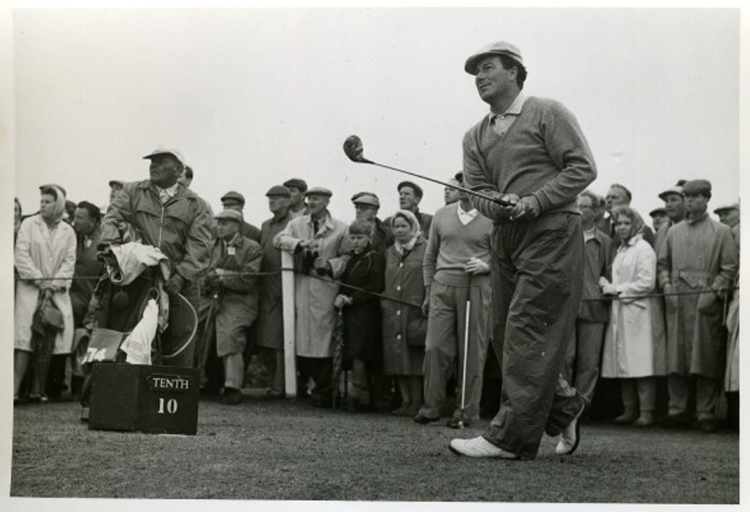Blog/Opinion By Jim Davis
Slow play has been discussed for years now and what with the demands on modern professional golfers, it seems something will have to give. Here is an excerpt from a discussion with the late great Australian golfer Peter Thomson and his take on the problem. Click on the link following the excerpt to read the full interview from Global Golf Post.

Q: Can you remember roughly how long a Championship round would take you, in your prime of the late 1950s?
Peter Thomson: Oh yes. Three hours and twenty minutes. In a pair. We would be walking to our golf ball and sizing up what club we might need for the next shot, when we got to the ball we would pull the club and hit it. In 1952 at Lytham (Royal Lytham & St Annes) Bobby Locke won the championship by one stroke, from me. Norman Von Nida went off his head yelling and screaming and saying that Locke should be disqualified, or at least given a two-stroke penalty, for playing slowly. They clocked him at three hours and twenty minutes. I remember the final of the 1948 Victorian Amateur championships, I got knocked out in the semifinals, but I went to watch the final and they sped around in two hours and 20 minutes.
One of the problems with the modern clubs is that it takes too long to play the course. … it is more than half a day. That dismays a lot of people. I am a member at Victoria Golf Club and on Saturday there would be 100 players before 10am, because they want to go and watch the footy in the afternoon. That is not possible anymore, forget it, it takes five hours to get around!
Click here to read the full interview.
Recently, at the Honda Classic, Charles Schwartzel unloaded on an official when his group was put on the clock for slow play. Such rulings rankle when a player is trying to focus on his game. It adds another “thing” to think about. Schwartzel said he was more upset with the way the “situation” was handled than the ruling itself.
Regardless of how the pros react, slow play seems to be endemic and growing like a fast-spreading tumor. It’s a cancer on the tour, one might say, reminiscent of something mentioned during the Nixon presidency.
The nature of the game has certainly changed. We now have 7,000+ yard courses, enormous purses, high tech clubs and high strung thoroughbred players straining to the demands of distance and accuracy. It is the modern game. It will take longer. More often than not, when a modern player reaches his ball, he will consult a yardage book a couple of times, toss grass in the air to test the wind a couple of times or three, check with his caddy on various and sundry matters, pull a club from the back, swing it a couple of times, put it back and pull another, swing it a couple of times, and go back to the first one. Then, maybe, they will step up to hit the thing. They all do this to one degree or another. They have been taught this by swing coaches and personal psychologists.
It is not their fault. The modern game demands this and the modern players are doing their best to meet these demands. If they wish to compete for today’s titles and money, they need to acknowledge these conditions, these requirements, and manage them as best they can. When you are working toward a big payday, you want to be sure you’ve got the right club for that 8-mph breeze from the left to reach a hole exactly 156.4 yards away.
High strung? It’s no wonder a Schwartzel, and others, will unload on an official who is pressured from his bosses to enforce a new emphasis on curbing slow play.
This demand upon modern players for ultra-high tech performance against the desire to curb slow play is a pressure point that is building to an inevitable quake. Schwartzel and others who chafe at being put on the clock and who verbally share their annoyance, are symptoms of that pressure, steam vents, as it were, that are a sign of the unbalanced nature of things. Something’s going to give.
This is one of the reasons, I think, that modern hickory golf has an appeal for a good many players. They look for shorter, traditional tracks where their clubs are suited for a greater variety of challenges and shotmaking possibilities. It simply does not take as long to play. The clubs are near-infinite in their variety and require more from each player in order to perform to their best.
There are other reasons some find greater joy in a round of hickory golf, but we are talking about slow play, and if modern golf could somehow find the challenge it needs from the hickory style of play, could find a popular brand of hickory tournament that would meet the needs of modern fans, sponsors, and money, then, I think we’d have a new style of made-for-TV event that would be every bit as exciting, on more levels, than what now passes for the modern professional game.
How much more interesting it would be to hear Paul Azinger or Nick Faldo comment on a player’s decision to go to a Nicoll/Braid approaching cleek rather than, say, a MacGregor mid iron for an approach to Merion’s tricky 13th. Heaven only knows how a caddy would signal such a club to the on-course commentator. Can you imagine a David Feherty trying to interpret that communication?
You get the idea. I think such a tournament would be enormous good fun throughout and provide a vast new vocabulary for television audiences not to mention new challenges for everyone involved, from players to viewers and fans. Might have a bit more fun, too, and it certainly would not take five or more hours.
